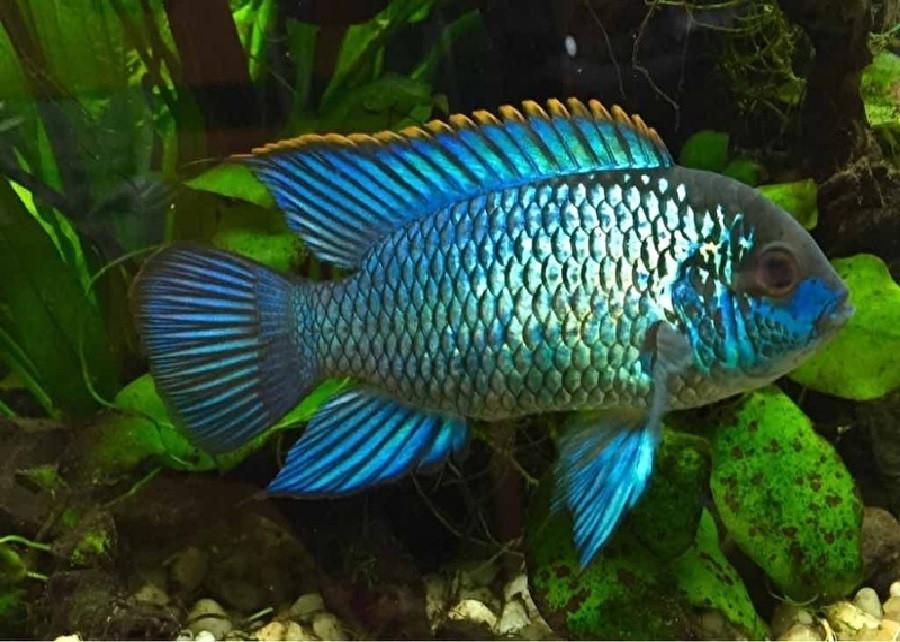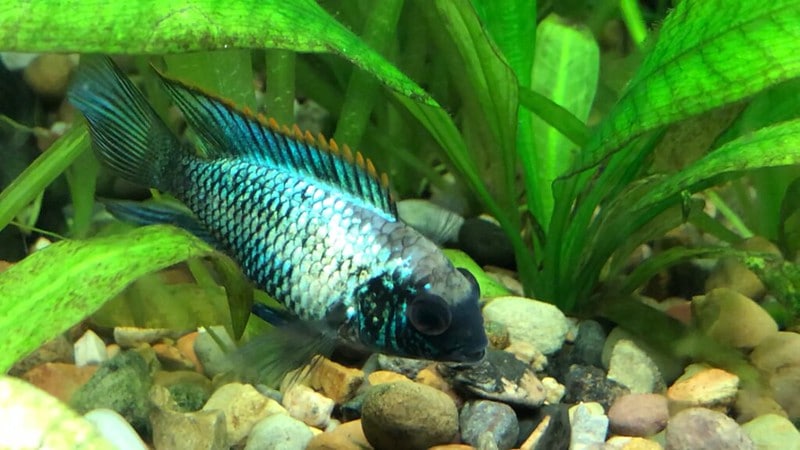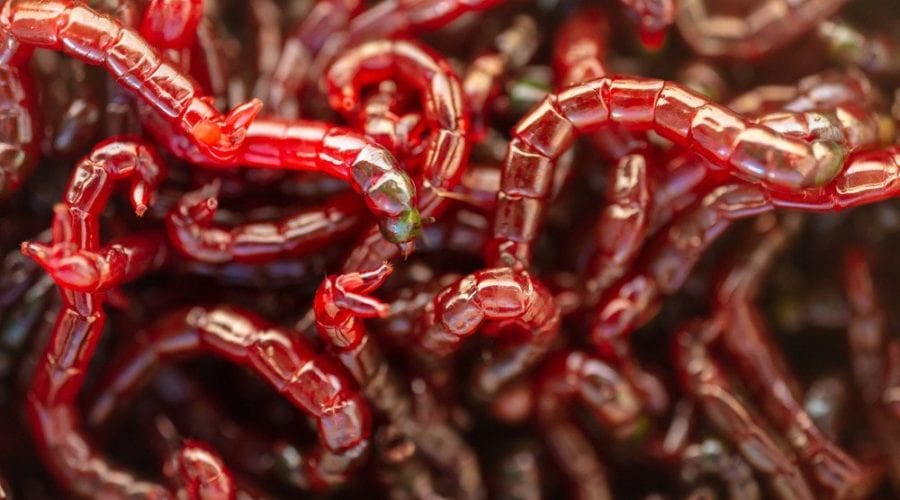The electric blue acara has been very popular among beginner and advanced aquarists. The shiny and bright colors they have are completely mesmerizing. This fish will definitely brighten up the mood in your aquarium.
Besides the stunning colors they have, the blue acaras are quite peaceful and sociable by default. They are not as aggressive as other fish from Cichlid species, but they can get pretty territorial and aggressive during the breeding season. Don’t worry, you can just move them to another tank, and there will be no major problems.
Their peaceful and friendly behavior makes them suitable for a community tank. They can get along with other fish in your tank. You only need to make sure that the other inhabitants are about the same size.
One other thing that makes electric blue acaras fancied by many people is that they are easy to care for. If you’re planning to get some of these gorgeous fish, you can keep reading. You will find some care guides that might be useful during your fish-keeping journey.
Table of Contents
Electric Blue Acara Species Overview
| Common Names: | Electric Blue Acara, Blue Acara |
| Scientific Name: | Andinoacara pulcher |
| Family: | Cichlidae |
| Size: | Up to 7 inches |
| Life Expectancy: | Up to 10 years |
| Origin: | Central and South America, Venezuela, and Trinidad |
| Care Level: | Easy |
| Temperament: | Peaceful, but can be territorial when spawning |
| Compatibility: | Community Fish |
| Diet: | Omnivores |
| Breeding: | Egg layer |
| Minimum Tank Size: | 30 gallons |
| Water Temperature: | Tropical, 72–86 °F (22–30 °C ) |
| Water Hardness: | 2 – 20 dGH |
| Water pH Level: | 6.5-8.0 |
| Tank Conditions: | Freshwater, Uproots Plants, Sand and Gravel, Rocks and Caves |
Origin and Distributions
These stunning blue-colored fish are originally found in Central and South American areas such as Columbia, Venezuela, and Trinidad. They can be found swimming in shallow rivers with slow streams and calm water. They can survive in still lakes as well. In the wild, they usually feed on worms, crustaceans, or insects.
They are very adaptive, making a wide distribution range for them. They can survive in most Central and South American areas, where the water is calm and relatively warm.
Appearance

Just by looking at its name, you may have guessed that this fish is electric blue-colored. And you’re right!
Young Electric Blue Acara’s body usually has a pale, shiny blue color, but as they grow older, their color becomes more vibrant.
Although the fish is called electric blue, there’s some variety in its colors besides just blue. Some electric blue acara have a rather metallic gray, bluish-green, or faded yellow color. You might also see stripes and dots on their bodies.
Also, don’t be surprised if you see their heads have different colors. Many electric blue acara has a gray or black colored head, but that’s totally normal.
As it’s been mentioned earlier, the blue acara has rich colors which you can enjoy. And it’s no exception for their fins. Most of the time, you can see the yellow or orange horizontal lines along the blue acaras’ fins.
Electric blue acara has rather pointy dorsal and anal fins. The fins are longer in male specimens than in females.
As for their build, they have typical cichlid bodies. The electric blue acaras are long and have an average thickness for their bodies.
Typical behavior
The Electric Blue Acaras is incredibly famous among aquarists, not without reason. Besides having eccentric colors, they also behave nicely. The Electric Blue Acara is particularly different compared to other fish in the Cichlid family.
They are unaggressive, peaceful, and very active. It’s absolutely amusing to watch them swim around in the tank. They may follow your movement from outside the tank too!
Since they are very active, you will often see them swimming around to explore the tank and dig actively through the substrate. They like to search for some things to nibble on. If you put some plants in the tank, they might uproot it, so watch out!
When this fish is tired, you can find them stopping under the plants and rocks or caves, if you have any.
Size and Lifespan
Unlike other Cichlids, the electric blue acara is not very big in proportion. Their maximum size is 7 inches long when fully grown. They can be considered mid-range fish and are suitable for your average or large-sized tank.
When kept in aquariums, electric blue acara has a lifespan from 8 to 10 years on average. But it can be doubled if they’re in their natural habitat!
If you want to keep your blue acara for quite a while, make sure they are taken care of properly. A clean and well-maintained aquarium will be best for them. That will prevent stress and diseases that shorten their lifespan. Check the water condition regularly and their diet as well (don’t overfeed them!).
Tank and Environment

The electric blue acaras love to dig and hide. A soft and sandy substrate is advisable for you if you have blue acaras in your tank. What about gravel, then? Since gravel is pretty rough, it may cause harm to your blue acaras, so we don’t really recommend it.
If you’re feeling a bit extra, try to find dark-colored sandy substrate. It will complement blue acaras’ shiny, bright colors and make them really popped.
The blue acaras like to rest and settle in between dense plants or rocks. You can also provide them caves for them to hide when they’re stressed.
Lastly, you can put dried leaves in your tank. In the wild, their water is filled with leaves litter. Mimicking the fish’s natural habitat will help them to feel more lively and happy.
Tank Size
Tank size is one crucial matter if you want your fish to thrive. The electric blue acaras are not tiny fish, and they need sufficient room to swim freely. A tank size of 30 gallons (minimum) is recommended. If you want to keep any extra fish, you have to add 15 gallons per new fish. By doing this, you can hopefully keep your fish happy and healthy.
Tank Condition
The rivers or lakes where the blue acaras live in their natural habitat are heavily vegetated and filled with leaves litter. This condition prevents bigger fish or predators to see and prey on them. In other words, the blue acaras feel safe and happy with many plants surrounding them.
Besides, the plants will also help to block too much light from entering the tank.
Other than plants, consider putting some rockwork and caves in the aquarium as well. As we discussed earlier, the blue acaras really like to hide. Therefore, providing them some hiding places can surely make them feel happy in lives the tank.
Make sure to also check the water condition regularly. A well-maintained and clean tank will support your fish to thrive and live optimally.
Plants and Decorations
Filling up your tank with many plants and decorations sounds like a good idea. That is because the blue acaras love to hide and settle in between plants or rocks when stressed. You can also put some driftwood or caves for their extra hiding and resting places.
The blue acaras are active diggers, so they might uproot the plants. In that case, potted or floating plants will suit them best. Some plants that may be perfect for your blue acaras are:
- Amazon Sword
- Anubis Nana
- Hornwort
- Java Fern
- Java Moss
- Vals
If you have other fish species in your tank that like to eat the plants, you must keep an eye on them. They might be nibbling together with your electric blue acara.
Water Parameters
Maintaining the water condition much like the blue acaras’ natural environment will help them live happily. Originated from Central and South American areas, the blue acaras prefer warm tropical water. Water temperature from 72 to 86°F (22–30 °C) with a pH ranging from 6.5-8.0 will be suitable for these cichlids. As for water hardness level, it can range between 2 and 20 dGH.
Diet and Feeding

For your fish to thrive and be healthy, you need to maintain a rich and balanced diet. It’s best if you can duplicate their diet just like in their natural habitat as much as possible.
Electric blue acaras are omnivores, but they eat mostly a meaty-protein diet. In the wild, they feed on crustaceans, insects, or worms.
In your captivity, you can feed them live food. Bloodworms, brine shrimps, and earthworms will do. You can also give them small insects, just like in their natural environment.
To keep their diet balanced, it’s important to give them plant-based food as well. After all, the blue acaras are omnivores and they enjoy varieties in their food. Other foods you can feed them include flaked foods or pellets.
Keep in mind that you need to feed them twice or three times a day. The blue acaras are peaceful fish, but they are voracious eaters. You should give them just an adequate amount of food each time you feed them. Leftover food might lead to fighting with other fish, in case you put them in a community tank.
Electric Blue Acara Tank Mates
The electric blue acaras are peaceful, unaggressive, and quite sociable. For that reason, they can make great tankmates with various other fish species. Keep in mind that you need to put only fish around their size. That’s because bigger-sized fish may be aggressive and threatening towards your blue acaras. On the other hand, smaller fish or creatures like ghost shrimp may end up as dinner.
If you’re planning to make a community tank, here are several fish that are compatible with the blue acaras:
- Banded Cichlids
- Bristlenose plecos
- Corydoras catfish
- Discus
- Otocinclus
- Rainbowfish
- Pearl cichlids
- Angelfish
Above are just suggestions on what you could get to accompany your blue acaras. It is still best to keep them in their own groups. Although keeping them with other fish species doesn’t sound like a bad idea at all. You only need to find the most compatible tankmates from your judgment and consideration.
Common Diseases
Blue acaras are very hardy. There is no particular disease that happens exclusively to them. However, there are still some conditions or symptoms you can look out for. The most common diseases the blue acaras might get are ich and skin flukes, which also happen with any type of fish.
Ich (White Spot Diseases)
Ich is a skin disease caused by parasite ciliate, Ichthyophthirius multifiliis. If your fish suffer from this disease, it indicates dirty tank water. This parasite affects all freshwater fish as well.
There are some symptoms you will notice if your fish caught the disease. First, they will breathe more rapidly than usual. Secondly, you will see them flicking themselves against plants and rocks. Then, they’ll develop white patches or dots on their body.
The parasite stays in the water, so the best way to tackle it is to take care of the whole tank. You can change the water or put medication into the water. Raising the water temperature to 82°F will also help the fish recover.
Malawi Bloat
Malawi bloat can be caused by various factors. That includes dirty tank condition, poor diet, and Clostridium difficile bacteria.
Common symptoms that recognizable are loss of appetite, discolored feces, and the appearance of ulcers and lesions. You can treat your infected fish by quarantining them in a separate tank and with antibiotics.
Skin flukes
Skin flukes are tiny parasites that ingrain themselves in your fish. Infected fish will show symptoms such as excess mucus, itchiness (they can be seen rubbing themselves on tank decor), red skin, and loss of appetite. The correct treatment for this disease would be using an over-the-counter drug (as directed) and correct the water parameters.
Breeding
Most blue acaras are ready to spawn when they reach the size of 4 inches. Another characteristic you may notice is also the change in their colors. Their colors intensity will increase and become more vibrant. The ready-to-mate blue acaras will get closer to each other more frequently. You will also see them spend more time on the bottom of the tank. They will also remain together after the spawning time!
Breeding Tank (water condition and parameter)
When you consider that your blue acaras are ready to mate, it’s recommended to put them in a separate tank. In terms of size, the breeding tank needs to be 20 gallons minimum. Water temperature from 73 to 79°F with a pH ranging from 6.5 to 7.0 will be best for blue acaras breeding. The water hardness should be between 3 and 12 dGH, which is soft to medium.
You can fill the bottom of the breeding tank with soft sandy substrate. Any color will do. There also need to be fewer plants and caves than in the main tank. What to note is, you need to put a sufficient amount of rocks with flat surfaces. These are the places where female blue acaras will deposit the eggs. The female lays up to 200 eggs on rocks surfaces.
The eggs will hatch, and you can see juvenile blue acaras within two or three days. During the first few weeks, the babies will stay close to their mother and be guarded by both parents.
It’s not difficult to breed them in a house tank. Healthy blue acaras can mate several times within a year.
In Conclusion
We can agree that the electric blue acara is one attractive fish that can make your tank look more festive. On top of that, the gorgeous fish is also relatively easy to care for.
The blue acara is friendly, so they’re compatible to be tankmates for your fish.
You can also breed them in your house tank. You won’t need to spend so much effort on them, regardless of being a beginner or not.
Just keep in mind that they are no tiny fish. So medium or large-sized tanks suit them best since they will likely swim around actively. You can place some plants and decorations too. It will keep them happy.
Also, make sure to maintain their diet balanced. The blue acaras love varieties in food. You can feed them meaty food, as well as plant-based foods.
Now that you’ve been introduced to the electric blue acara, do you think they’re suitable for you?
We hope the tips and care guide we shared will help you care for your electric blue acara. If you have any other tips or interesting experiences with your blue acaras, let us know! We’d love to hear from you.






